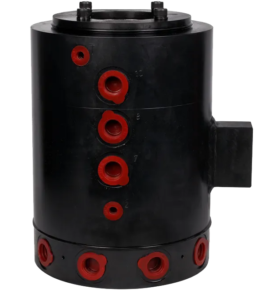Latest News
The latest and greatest project news
What Is a Hydraulic Swivel Joint?
A Hydraulic Swivel Joint, also known as a rotary joint or rotary union, is a mechanical device that allows the transfer of fluid (either liquid or gas) from a stationary source, such as a pipe or a hose, to a rotating part, like a drum, spindle, or cylinder. The primary function of a rotary union is to maintain a fluid connection while allowing full 360-degree rotation of the connected parts. These joints are essential in applications where the hydraulic hose cannot twist without damaging the system, ensuring operational efficiency and longevity.
The significance of a Hydraulic Swivel Joint cannot be overstated. It’s the heart of many hydraulic systems, playing a critical role in a wide range of industrial applications. From agriculture to construction, these joints are pivotal in enhancing equipment functionality and reliability.

Table of Contents
What Are the Components of a Hydraulic Swivel Joint?
- Housing: This is the outer casing that supports and protects the internal components of the swivel joint. It is typically made of metal and can withstand the stresses of operation.
- Shaft or Spool: This is the inner part that rotates within the housing. The hydraulic fluid flows through channels within the shaft, allowing for the transfer of fluid while the shaft rotates.
- Bearings: Bearings are used to support the rotating shaft within the housing and allow it to turn smoothly with minimal friction. They can be ball bearings, roller bearings, or other types designed for the load and rotation speed.
- Seals: Seals are crucial in preventing fluid leakage and maintaining the pressure within the swivel joint. They need to be resistant to the hydraulic fluid and the operating pressures and temperatures.
- Ports: These are the connection points for hydraulic lines. The swivel joint will have at least two ports, one for the hydraulic fluid to enter and another for it to exit.
- Retaining Rings or Snap Rings: These are used to secure the bearings and other components within the housing. Wear Pads or
- Bushings: These components are sometimes included to absorb the wear and tear that can occur from the rotation, extending the life of the swivel joint.
- Passages: Internal channels within the spool or shaft allow the hydraulic fluid to flow through the swivel joint. In multi-passage swivel joints, there may be several independent channels for different fluid circuits.
How Does a Hydraulic Swivel Joint Work?
What are the Common Applications of Hydraulic Swivel Joints?
Hydraulic swivel joints are utilized in a multitude of applications where a rotating connection is needed for the transfer of hydraulic fluid under pressure, from heavy machinery in construction sites to precision equipment in manufacturing plants. Their versatility makes them an essential component in industries like agriculture, aerospace, and marine.
Construction Equipment: In machinery like excavators, backhoes, and cranes, swivel joints allow for the rotation of booms and arms while maintaining hydraulic fluid flow to actuators.

Agricultural Machinery: Swivel joints are used in tractors, combines, and other farm equipment to enable the movement of hydraulic-driven implements.

Mining Machinery: They are crucial in mining equipment where components like drills and buckets must rotate under high-pressure conditions.

Industrial Manufacturing: In assembly lines and automated manufacturing equipment, swivel joints facilitate the movement of parts and tools without hindering the hydraulic power supply.

Marine Applications: On ships and docks, swivel joints are used in cranes, winches, and steering mechanisms to manage the movement in harsh marine environments.

Oil and Gas Industry: In drilling rigs and offshore platforms, hydraulic swivel joints enable the rotation of the drill while maintaining the circulation of drilling fluids.
Aerial Work Platforms: Swivel joints allow the platforms to move in different directions while providing hydraulic power for lift and extension functions.

Forestry Equipment: Used in logging machinery, swivel joints enable the articulation of booms and the operation of saws and other cutting equipment.
Robotics and Automation: They are used in robotic arms and automated systems where precise and smooth movement is required.
Food and Beverage Processing: Stainless steel swivel joints are used in processing equipment for easy cleaning and to avoid contamination.
Car Wash Systems: Swivel joints in these systems allow for the free rotation of washing brushes and arms.
Firefighting Equipment: Fire trucks use swivel joints in their ladder and water delivery systems to direct water flow as the ladder is extended and moved.
How to Choose a Hydraulic Swivel Joint?
There are many factors that you should consider when choose a hydraulic swivel joint. Here I will list some key points to take into account:
Pressure Rating: Select a swivel joint that can handle the maximum pressure of your hydraulic system. The pressure rating should exceed the system’s maximum operating pressure to ensure safety and longevity.
Flow Requirements: Consider the flow rate that the swivel joint must accommodate. Make sure the internal passages are appropriately sized to handle the flow without causing excessive pressure drop.
Fluid Compatibility: The materials of the swivel joint should be compatible with the hydraulic fluid used. Incompatibility can lead to seal degradation, leaks, and joint failure.
Size and Space Constraints: Ensure the physical size of the swivel joint fits within the available space and that the connection sizes match those of the existing hydraulic system.
Rotation Requirements: Consider the degree and frequency of rotation the joint must endure. This can affect the type of bearing and seal design you need.
Temperature Range: The swivel joint should be capable of operating within the temperature range of the application. Temperature can affect seal integrity and lubrication.
Material Durability: Choose materials that offer the durability required for the application’s environment, whether it’s exposure to corrosive substances, extreme temperatures, or physical wear and tear.
Seal Type: The seals are critical for preventing leaks and maintaining pressure. They should be selected based on the fluid type, pressure, temperature, and rotational speed.
Customization Options: Some applications may require custom-engineered swivel joints. Check if the manufacturer can provide custom solutions tailored to your specific needs.
Materials Used in Hydraulic Swivel Joints
The materials used in the manufacturing of hydraulic swivel joints are selected for their durability, strength, and compatibility with hydraulic fluids and operating environments.
Steel: Often used for its strength and durability. Carbon steel is typical for general applications, while alloy steels are used for higher strength and toughness in demanding applications.
Stainless Steel: Preferred for its corrosion resistance, especially in harsh environments or with corrosive fluids. It’s commonly used in food processing, marine applications, and environments where cleanliness is paramount.
Brass: Known for its corrosion resistance and non-sparking properties, brass is used in applications where corrosion resistance is important, but the pressures are not excessively high.
Aluminum: Chosen for its light weight and good corrosion resistance, aluminum is used in applications where weight is a critical factor, such as in mobile machinery.
Ductile Iron: Offers better strength and durability than standard cast iron and is often used in heavier-duty applications.
Bronze: Sometimes used for components like bearings or bushings in swivel joints, bronze provides good wear resistance and can withstand higher temperatures than some other materials.
Elastomers and Plastics: Used for seals and O-rings within the swivel joint. Materials like Nitrile, Viton, PTFE (Teflon), and Polyurethane are common, chosen for their compatibility with different types of hydraulic fluids and their ability to withstand various pressure and temperature ranges.
Composite Materials: In some modern designs, composite materials are used for certain components to reduce weight, resist corrosion, and reduce manufacturing costs.
The choice of material for a hydraulic swivel joint depends on several factors, including the pressure and temperature range of the system, the type of hydraulic fluid being used, environmental conditions (like exposure to chemicals or saltwater), and the mechanical demands of the application. In some cases, surfaces of the swivel joint components may also be treated or coated to improve performance characteristics like wear resistance or to protect against corrosion.
Hydraulic Swivel Joints Features
Hydraulic swivel joints come with a range of features designed to ensure efficient and reliable operation in various hydraulic systems.
360-Degree Rotation: They allow for full rotational movement, which is crucial in applications where parts of the machinery need to move or rotate independently.
High-Pressure Capability: Hydraulic swivel joints are designed to withstand high-pressure conditions, ensuring a secure and leak-free connection even under strenuous operating conditions.
Durable Seals: Equipped with robust seals to prevent fluid leakage and maintain the integrity of the hydraulic system. These seals are made from materials compatible with different types of hydraulic fluids and operating temperatures.
Versatile Material Construction: Made from various materials like steel, stainless steel, brass, and aluminum to suit different environments and applications, including those with corrosive fluids or high-temperature conditions.
Load-Bearing Capacity: Designed to handle both the pressure of the hydraulic fluid and the mechanical loads imposed by the attached components, ensuring reliable operation under dynamic conditions.
Multiple Passage Options: Available in single-passage and multi-passage designs, allowing for the simultaneous transfer of multiple fluids or gases through a single joint.
Compact and Robust Design: Engineered to be as compact as possible without compromising strength and durability, enabling use in confined spaces and in applications where size and weight are critical factors.
Low Friction Bearings: Incorporate bearings that reduce rotational friction, facilitating smooth and consistent movement, which is essential for maintaining system efficiency and longevity.
Customization Availability: Many manufacturers offer customizable options to meet specific requirements, such as custom sizes, materials, and connection types to fit unique applications.
Ease of Maintenance: Some designs allow for easy maintenance, including the replacement of seals and bearings without the need to completely disassemble or remove the swivel joint from the system.
Corrosion Resistance: Depending on the material and coatings used, they can be highly resistant to corrosion, making them suitable for harsh environments.
Temperature Range Adaptability: Capable of operating within a wide range of temperatures, thanks to materials and seals that can withstand both high and low-temperature extremes.
Vibration and Shock Resistance: Built to withstand the rigors of applications where vibration and shock are prevalent, ensuring consistent performance and reducing the risk of failure.
These features make hydraulic swivel joints integral components in various industrial, agricultural, construction, and marine applications, providing the flexibility and reliability needed in complex hydraulic systems.
Hydraulic Swivel Joints Technical Specifications
The technical specifications of hydraulic swivel joints can vary widely depending on their intended application, design, and manufacturer. However, some common specifications that are typically considered when selecting a hydraulic swivel joint include:
1. Pressure Rating
Maximum operating pressure that the swivel joint can withstand without failure or leakage. This is usually expressed in pounds per square inch (psi) or bar. Usually, some models could reach up to 6000PSI, which is always applied in some heavy equipments, such as excavator, crane and drilling machinery. The joint’s capacity to withstand increased pressure reflects its suitability for intense operations and is a key factor in determining its longevity and how well it can be integrated with different types of machinery.
2. Size and Dimensions
Hydraulic swivel joints are available in various sizes, ranging from 1/4 inch to 10 inches maximum, and the selection of size depends on the required fluid flow rate and speed, as well as the operating/working pressure, with smaller joints typically used for low-intensity tasks and larger ones for more demanding, industrial applications, where the size is directly related to both the pressure capacity and the fluid flow rate the joint can accommodate.
3. Temperature Range
Hydraulic swivel joints are capable of operating effectively across a vast temperature range, typically from -40 degrees Celsius to 200 degrees Celsius, showing their ability to perform reliably in both extremely cold and hot conditions, while consistently maintaining fluid flow and rotational functionality.
What Are the Alternatives to Hydraulic Swivel Joint?
While hydraulic swivel joints are crucial in many applications, there are alternatives that can be used depending on the specific requirements of the system. Some of these alternatives include:
1. Rotary Unions
Similar to swivel joints, rotary unions are used to transfer fluid between stationary and rotating components. They are often used in applications with slower rotation speeds or less demanding conditions.
2. Ball Joints
These can be used to provide angular movement in two planes, though they are not typically used for fluid transfer.
3. Flexible Hoses
In systems where limited movement is required, flexible hoses can be used. They provide some degree of flexibility and can absorb movements without the need for a rotating joint.
4. Rigid Piping with Articulated Sections
In certain applications, rigid pipes with articulated sections or bends can provide the necessary movement without the use of a swivel joint.
5. Universal Joints
While not common for hydraulic fluid transfer, universal joints can be used in some mechanical systems to transfer motion between misaligned shafts.
6. Slip Rings for Electrical Systems
For the transfer of electrical power or signals in a rotating interface, slip rings are an alternative, though they do not transfer hydraulic fluids.
7. Electric Actuators
In some modern applications, electric actuators are used as an alternative to hydraulic systems, thus eliminating the need for hydraulic swivel joints.
What Are the Causes of Hydraulic Swivel Joints’ Failure?
Hydraulic swivel joints can fail due to a variety of reasons, often related to operational stresses, environmental conditions, or maintenance issues. Understanding these causes can help in preventing failures and extending the life of the joints. Common causes of failure include:
Excessive Pressure: Operating beyond the rated pressure can cause seal failure, leaks, or even catastrophic joint failure.
Improper Installation: Incorrect installation can lead to misalignment, which puts additional stress on the joint and can cause premature wear or failure.
Wear and Tear: Over time, normal wear can degrade seals and bearings, leading to leaks or reduced performance.
Corrosion: Exposure to corrosive substances or environments can weaken the joint materials, leading to leaks or structural failure.
Temperature Extremes: Operating outside the recommended temperature range can damage seals and other components, reducing their effectiveness.
Contamination: Hydraulic fluid contamination with dirt, debris, or water can damage internal components, especially the seals.
Improper Maintenance: Lack of regular maintenance, such as not changing worn seals or not lubricating bearings, can lead to premature failure.
Vibration and Shock Loads: Constant vibration or shock loads can cause mechanical wear and fatigue, leading to failure over time.
Material Fatigue: Repeated stress cycles can lead to material fatigue and eventual failure, especially in high-load or high-rotation applications.
Improper Material Selection: Using a swivel joint with materials not compatible with the hydraulic fluid or environmental conditions can lead to rapid deterioration.
Design Flaws: In some cases, the design of the swivel joint may not be suitable for the application, leading to inherent weaknesses and failure.
Maintenance and Cleaning of Hydraulic Swivel Joints
Proper maintenance and cleaning are essential for the longevity and optimal performance of hydraulic swivel joints. Here are some key steps and considerations for maintaining and cleaning these components:
Regular Inspection: Periodically inspect the swivel joint for signs of wear, leaks, or damage. Check for any signs of corrosion or mechanical damage on the external surfaces.
Lubrication: If the swivel joint has lubrication points, ensure regular lubrication with the appropriate grease or oil as specified by the manufacturer. This helps in reducing wear and tear on moving parts like bearings.
Seal Inspection and Replacement: Check the condition of seals regularly and replace them if they show signs of wear or damage. Worn seals are a common cause of leaks and reduced performance.
Cleaning the External Surface: Keep the external surface of the swivel joint clean. Remove any dirt, debris, or fluid residues using a suitable cleaning agent that does not damage the joint material.
Checking for Alignment and Tightness: Ensure that the swivel joint is correctly aligned in the system and that all connections are tight. Misalignment can cause undue stress and premature wear.
Fluid Quality Check: Regularly check the quality of the hydraulic fluid. Contaminated or degraded fluid can adversely affect the performance and lifespan of the swivel joint.
Avoiding Overloading: Ensure that the swivel joint is not subjected to pressures or loads beyond its specified capacity. Overloading can cause rapid deterioration and failure.
Environmental Protection: If the swivel joint is used in harsh environments, consider additional protective measures such as protective covers or coatings to shield it from corrosive substances or extreme conditions.
Replacing Worn Components: Apart from seals, other components like bearings or the swivel itself may wear out and need replacement. Follow the manufacturer’s guidelines for replacement intervals.
Regular and proper maintenance not only extends the life of hydraulic swivel joints but also ensures they operate efficiently and safely, reducing the likelihood of unplanned downtime in the hydraulic system.
Conclusion
In conclusion, a hydraulic swivel joint is an essential component in many hydraulic systems, offering the flexibility of rotational movement while maintaining a secure and uninterrupted fluid connection. Its ability to withstand high pressures, varied temperatures, and diverse environmental conditions makes it indispensable in a wide range of industrial, agricultural, and construction applications. Understanding its function, materials, and maintenance requirements is key to ensuring its longevity and optimal performance in any hydraulic system.
FAQ About Hydraulic Swivel Joints
Q: Can hydraulic swivel joints be repaired or do they need to be replaced when damaged?
A: Whether a hydraulic swivel joint can be repaired or needs to be replaced when damaged largely depends on the extent of the damage and the design of the joint.
If the damage is minor, such as worn seals or bearings, it is often possible to repair the swivel joint. Replacing these components can restore the joint to full functionality.
In cases of severe damage, such as cracks in the housing, significant corrosion, or failure of critical components that cannot be individually replaced, the entire swivel joint may need to be replaced.
Q: Are there different types of hydraulic swivel joints for different applications?
A: Yes, hydraulic swivel joints come in various designs, including single-flow, multi-flow, and high-pressure types, each suited for specific applications.
Q: Can hydraulic swivel joints handle high pressure?
A: Yes, many are designed to handle high-pressure applications, but it is crucial to choose a joint with a pressure rating appropriate for the specific hydraulic system.
Q: What are the signs of a failing hydraulic swivel joint?
A: Common signs include leaks, restricted movement, unusual noises, and a decrease in system performance.
Q: What is the typical lifespan of a hydraulic swivel joint?
A: The lifespan varies depending on the application, usage, and maintenance, but with proper care, they can last for several years.
Recent Posts
Share This Story, Choose Your Platform.
Leave A Comment
Your email address will not be published. Required fields are marked *
